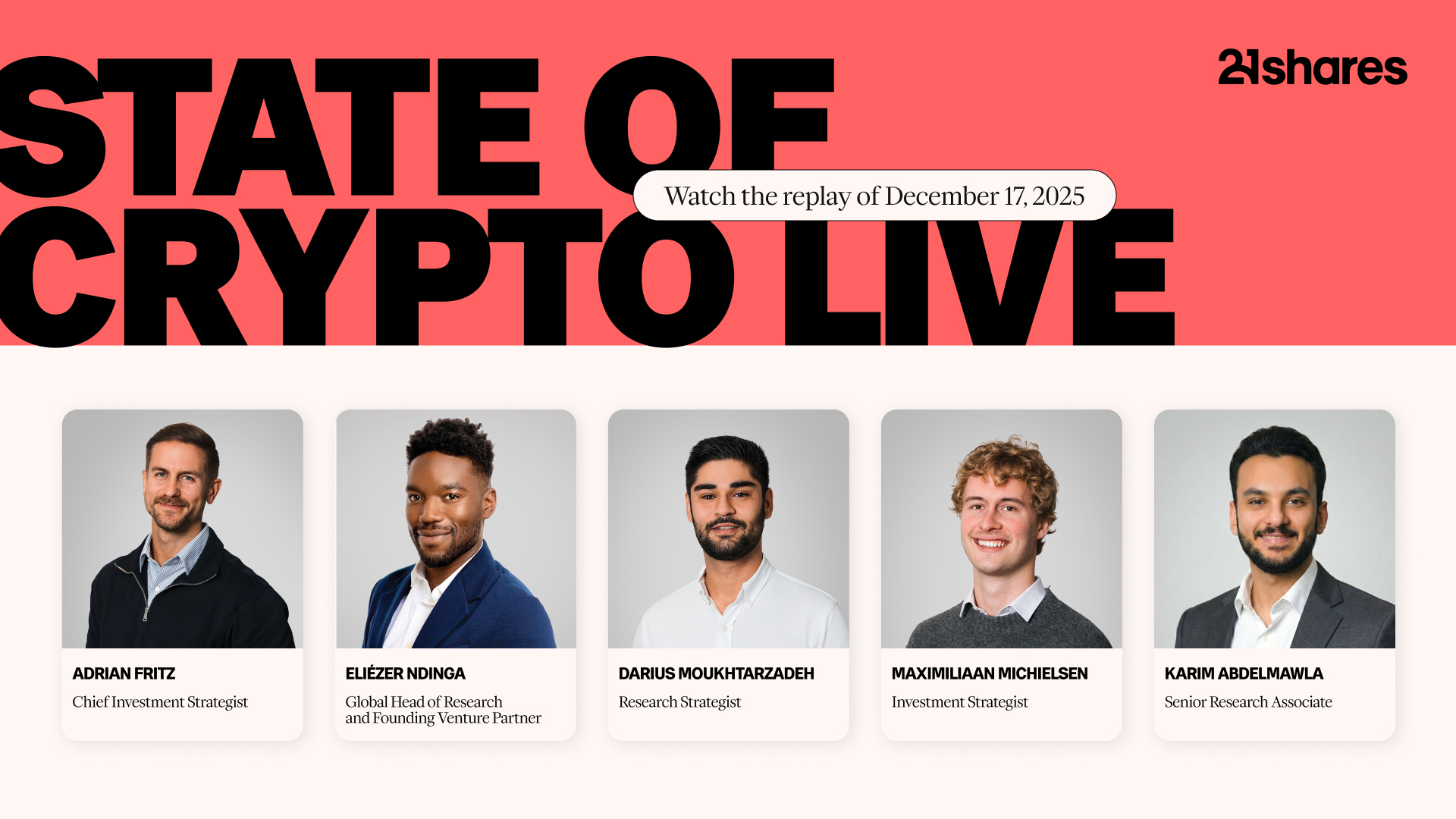Tezos & Ethereum Surge: Crypto Market Highlights
.jpg)


Market Outlook
The last week was marked by especially strong performance from Tezos (XTZ), Ethereum (ETH), and Litecoin (LTC). The performance of the latter two crypto assets is shown in our usual top-five performance chart and the performance of Tezos is shown in the graph below.
Interestingly, Tezos recently hit a 90-day high in its on-chain transaction volume (in XTZ terms), signaling that there has been a resurgence in usage of the Tezos blockchain for transactions and smart contracts. To put Tezos' performance in context, the crypto asset is up 47.04% since the start of the year compared to 29.41% for Bitcoin.
Given that Tezos' strong growth over the last year has inarguably been driven by an improvement in financial infrastructure around the asset — such as the 21Shares Tezos ETP (AXTZ) — and its increasing use as a platform for smart contracts and financial settlement, we see its recent price gains as likely to be sticky over the long-term. Interestingly, Ethereum's performance over the last week and extremely promising continued growth in its decentralized finance (DeFi) ecosystem signal that the market may begin to price smart contract-facilitating crypto assets more favourably when compared to Store of Value/Bitcoin (and forks) crypto assets (BTC, BCH, and privacy coins).
These factors mean that Ethereum and Tezos, as well as other smart contract platforms, are very likely to have an extremely strong year — as we argued in our State of Crypto Q4 2019 report. The chart to watch on this point is the one below which tracks the total value (in USD) locked in DeFi applications — which will likely surpass $1 billion in the coming months (note that this chart does not include data from Synthetix ($153.5M) or InstaDapp ($70.5M).
The performance of the top five crypto assets is as follows — BTC (-0.19%), ETH (8.02%), XRP (6.42%), BCH (1.80%), and LTC (15.54%).
Average adjusted transaction volumes were up by a noticeable amount from a total of $1.94B to $2.81B — BTC ($2.14B), ETH ($245M), XRP ($162M), BCH ($223M), and LTC ($45M).
Podcast - What Does the Bitcoin Halving Mean?
In this episode, the 21Shares team (Lanre, Hansen, and Rahul) came together to discuss the Bitcoin Halving with one of the leading crypto asset researchers in the industry, Hasu. In this episode, we give a detailed explanation of how exactly Bitcoin mining works and what impact the halving will have on the mining industry, Hasu's research on Bitcoin's economic security, and the efficiency of crypto markets.
Reading list: A Model for Bitcoin's Security and the Declining Block Subsidy; On the Instability of Bitcoin without a Block Reward; Bitcoin Block Reward Halving Countdown; Bitcoin Wiki — Controlled Supply
You can listen to the full episode on Apple Podcasts, Spotify, or Megaphone.
News - Mastercard Left Libra Association Over Regulatory and Viability Concerns, Says CEO | CoinDesk
What happened?
Mastercard's CEO says the firm pulled out of the Facebook-led Libra project after developing concerns over its business model and compliance. Ajay Banga, who has been the CEO and president of Mastercard since 2009, told the Financial Times his attitude towards Libra deteriorated as project members proposed linking what was supposed to be a globally inclusive currency to a proprietary digital wallet, Calibra. “It went from this altruistic idea into their own wallet. I’m like: ‘this doesn’t sound right,’" said Banga.
Why does this matter?
Banga also remarked on issues with how actually Libra and the Calibra wallet would actually help promote financial inclusion, as well as the lack of a clear business model for Libra. In his mind there were no obvious means for the Libra Association to become profitable or make money from its users; "When you don't understand how money get[s] made, it gets made in ways you don't like" he said.
None of these concerns is out of the norm and many have been mentioned by Libra-skeptics within the crypto asset industry; for example, Jill Carlson, investor at Slow Ventures and co-founder of the Open Money Initiative, discussed some of the issues with the financial inclusion narrative perpetuated by both Libra and those within the crypto asset industry.
It is likely that many, if not all the current and former members of the Libra Association have had similar concerns which are important to note as if we take Banga at his word, extend much further than just regulatory risks — perhaps. therefore, presenting existential hurdles for Libra, even if it were to successfully launch.
Learn more here.
News - Chainalysis Report Shows Criminal Uses of Bitcoin Doubled from 2018 to 2019 in BTC Terms | CoinDesk
What happened?
Chainalysis's 2020 "State of Crypto Crime" report, published Wednesday, offers an analysis of illicit activities last year, contrasting 2019's actions with previous years. Chainalysis found that while the amount of bitcoin sent from criminal entities doubled between 2018 and the end of 2019, it still accounts for just 0.08 percent of the total number of bitcoin transactions last year.
While exchange hacks and thefts dominated headlines last year, “scams were by far the highest-earning category of crypto crime in 2019,” the report said. “Cryptocurrency scams represent a significant danger to consumer protection, and the growth of this activity in 2019 calls for increased action from regulators, law enforcement and exchanges alike.”
Why does this matter?
There are two graphs which most accurately summarize the findings of the Chainalysis report. The first shows the total crypto assets sent and received by illicit entities vs. the illicit share of all crypto asset transaction volumes between 2017 and 2018.

The second graph shows a breakdown of the share of total crypto asset transaction volume by illicit subcategory.

While on the face of it, the fact that the amount of Illicit transaction activity is growing is undoubtedly a bad thing — it should be noted that the vast majority of the 2019 increase can be attributed to the 'scam' category whilst subcategories such as 'darknet markets' remained stable. Scams are, for a large part, preventable by regulators acting more swiftly against obviously illegitimate companies operating and raising money within the space.
Learn more here.
Disclaimer
The information provided does not constitute a prospectus or other offering material and does not contain or constitute an offer to sell or a solicitation of any offer to buy securities in any jurisdiction.
Some of the information published herein may contain forward-looking statements. Readers are cautioned that any such forward-looking statements are not guarantees of future performance and involve risks and uncertainties and that actual results may differ materially from those in the forward-looking statements as a result of various factors.
The information contained herein may not be considered as economic, legal, tax or other advice and users are cautioned to base investment decisions or other decisions solely on the content hereof.

.jpg)












_logo.svg)

.svg.png)